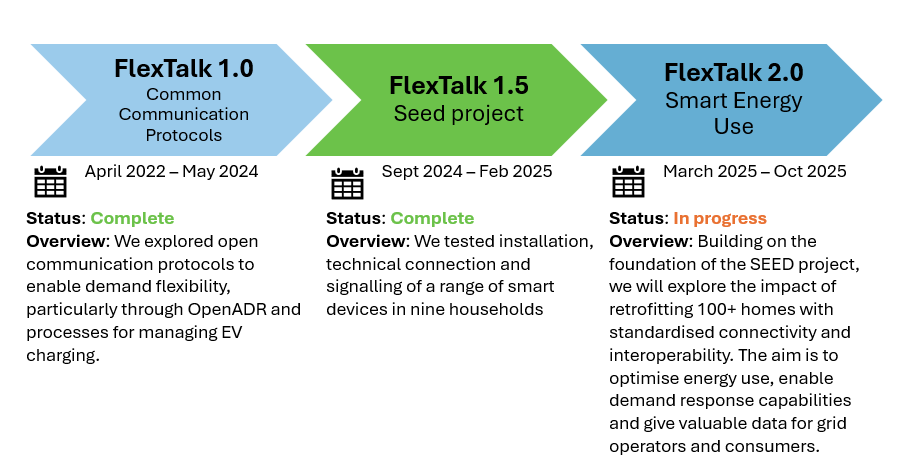
The EEA is leading the demand flexibility-focused project, FlexTalk in partnership with EECA (Energy Efficiency and Conservation Authority) and industry.
Our vision is to maximise participation in electricity demand flexibility services for the benefit of consumers and industry.
To achieve this vision, we have implemented a staged approach to test, learn and share our technical expertise, experience and knowledge. The focus is on making it easy for Kiwi consumers to participate in energy flexibility – starting small, learning fast and scaling smart.
Stage 1: Implementing a common communication protocol
We started with the exploration and trial of a common communication protocol – OpenADR® – to identify what could be accepted by the New Zealand electricity supply industry and enable parties seeking or providing flexibility services to easily procure, dispatch, and monitor such services.
Read our project reports below outlining our exploration of OpenADR®, technical insights on the programs tested and the technical approaches taken to implement OpenADR® and key recommendations for industry on its fit for the New Zealand context.
FlexTalk Summary July 2024
FlexTalk Final Report May 2024
FlexTalk Technical Insights Final Report May 2024
Stage 2: Small scale test of the installation and functionality of devices in homes
In 2025 we completed a small-scale test of the installation and functionality of devices in homes. The FlexTalk Seed Project, a collaboration between the EEA and Energy Efficiency and Conservation Association (EECA), was designed to explore and test the practical application of installing and signalling smart devices to enable demand flexibility in New Zealand.
The trial reinforced the importance of addressing several key challenges to enable widespread adoption of demand flexibility such as:
- Establishing clear market signals and regulatory frameworks that incentivise participation
- Ensuring interoperability and standardisation of demand-side technologies to enable seamless integration across the energy system.
- Scaling successful pilot projects into fully operational market solutions, driving meaningful impact.
Flextalk SEED report: assessment, findings and recommendations March 2025
Stage 3: Large scale trial of in-home smart devices 2025
We are planning a large-scale trial of in-home smart devices and consumer energy resources to manage flexibility on the electricity network, while ensuring stability, reliability and efficiency.
This trial will take place later this year.
FlexTalk in three stages – click the image to enlarge
Email us to sign up for FlexTalk updates
Why is demand flexibility so important?
Aotearoa New Zealand has committed to achieving net zero emissions by 2050 and an aspirational goal of reaching 100 percent renewable electricity generation by 2030.
Most new renewable generation will be intermittent in nature, coming from solar and wind sources, which will create challenges for the people operating our electricity system and managing intermittent supply against community demand.
The increasing uptake of electric vehicles, batteries and smart devices in the home is an opportunity for us to achieve greater flexibility in how demand is managed.
Energy system flexibility can help to facilitate the introduction of more intermittent renewable electricity generation and provide consumers with an opportunity to play an increasing role in the operation of the electricity network.
If left uncontrolled, increased electrification will require significant investment in network infrastructure and ultimately cost the consumer more via their electricity bill.
Reports and resources
| Read all of our published reports and resources here | Reports and publications |
| Previous FlexTalk webinars have been recorded and can be viewed here | FlexTalk Webinars |
| Read some of the more frequently asked questions about FlexTalk and demand flexibility | Frequently Asked Questions |


